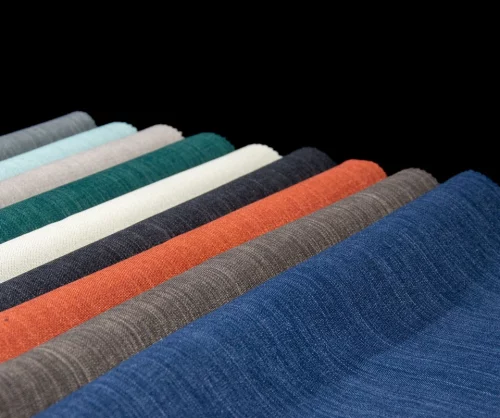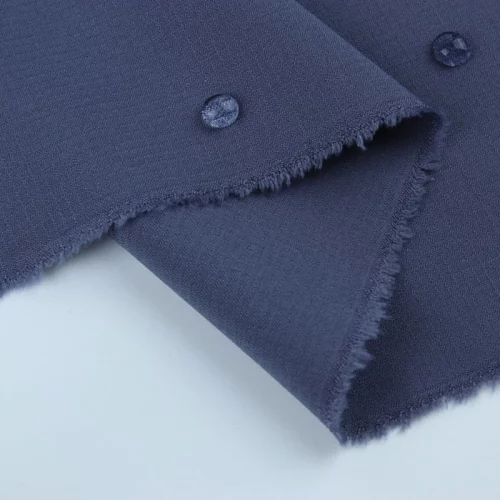
Tecido retardador de chamas vs. tecido resistente a chamas
Esta é sem dúvida a confusão mais comum quando se fala em tecidos retardadores de chamas e tecidos resistentes a chamas, mas na verdade existem diferenças muito marcantes. Tecidos retardadores de chama, materiais têxteis tratados quimicamente para resistir à ignição e inibir a taxa de propagação da chama. Esses têxteis normalmente compreendem o tratamento de vestuário (tecidos não resistentes a chamas, como algodão ou poliéster).
Os tecidos resistentes ao fogo, por outro lado, são feitos de fibras que não queimam naturalmente. A propriedade básica das fibras resistentes à chama é que elas não são facilmente inflamáveis e essas fibras se autoextinguirão rapidamente após a fonte de ignição ter sido removida. Ao contrário dos tecidos comuns, as fibras resistentes à chama requerem uma maior quantidade de energia para inflamar e também se autoextinguem quando a fonte de ignição é eliminada.
| Recurso | Tecido retardador de chamas | Tecido resistente a chamas |
| Composição | Fibras comuns tratadas quimicamente | Fibras inerentemente não inflamáveis |
| Durabilidade | Pode perder eficácia após a lavagem | Mantém propriedades ao longo da vida |
| Custo | Geralmente mais acessível | Normalmente mais caro |
| Aplicativo | Adequado para uso temporário | Ideal para uso protetor de longo prazo |
Classificação de tecidos retardadores de chama
Com base no processo de produção
- Tecidos retardadores de chama inerentes
Tecidos retardadores de chama inerentes são feitos de fibras que possuem propriedades naturais de resistência à chama. Estes tecidos permanecem protegidos durante todo o seu ciclo de vida, garantindo assim sustentabilidade e consistência em múltiplas aplicações. Alta lavabilidade, resistência ao desgaste, alta temperatura e resistência química permitem que sejam usados em metalurgia, campo de petróleo e indústria de proteção contra incêndio.
- Tecidos retardadores de chama pós-tratamento
Durante o processo de tingimento e acabamento, esses tecidos são tratados quimicamente para obter propriedades retardadoras de chama que podem ser classificadas como tecidos retardadores de chama pós-tratamento. Agora, essas propriedades são muito eficazes no início, mas começam a se desgastar depois que lavamos roupa em repetidas ocasiões ou expomos o tecido a certas condições. São principalmente filtros de absorção e menos lavagem, geralmente para cortinastel ou roupas de proteção descartáveis.
Com base na durabilidade da lavagem
- Tecidos retardadores de chama duráveis
Ao contrário dos tecidos retardadores de chama comuns que perdem as propriedades protetoras após a primeira lavagem, estes tecidos permanecem eficazes na repelência do fogo mesmo após múltiplas lavagens. Eles são destinados ao uso em situações que exigem lavagens e limpezas repetidas, mantendo intactas as possibilidades de retardamento de chama durante a vida útil da peça.
- Tecidos retardadores de chama não duráveis
Os tecidos retardadores de chama não duráveis perdem a sua eficácia após a lavagem. Geralmente são usados em ambientes onde a lavagem é pouco frequente, como cortinastel ou outros tecidos decorativos.
Baseado na composição
- Poliéster
O poliéster é popular em aplicações retardantes de chama porque já possui uma boa resistência à ignição e também é adequado para acabamento químico adicional para fornecer maior proteção.

- Nylon
Tecido de nylon retardante de chamas proporciona grande resistência e é naturalmente resistente à abrasão. Com propriedades retardantes de chamas, também é funcional para equipamentos externos, como barracas e mochilas, sem afetar seu desempenho na segurança. Com propriedades retardadoras de chama adicionais, eles podem ter um bom desempenho em equipamentos para atividades ao ar livre, como barracas e mochilas, e fornecer segurança sem sacrificar o desempenho.
- Algodão
O algodão pode ser tornado retardador de chamas através de processos de pós-tratamento. Embora seja naturalmente inflamável, o algodão tratado oferece conforto e respirabilidade, além de maior resistência ao fogo.
- Viscose
Pode dar a sensação sedosa da viscose por um preço mais acessível. A combinação de têxteis decorativos para o lar com o tratamento retardador de chama proporciona uma solução bastante atraente para decoração sem comprometer a segurança. Combinado com tratamentos retardadores de chama, proporciona aos têxteis-lar decorativos beleza e segurança157.
- Aramida
As fibras de aramida possuem resistência e resistência inerentes ao calor, tornando-as indispensáveis em indústrias de alto risco, como combate a incêndios e aeroespacial. O seu desempenho excepcional sob condições extremas garante uma proteção confiável.
- Acrílico
As fibras acrílicas também podem ser modificadas para características retardadoras de chama, proporcionando uma barreira eficaz, mas que economiza peso, que é útil em locais como móveis internos automotivos ou civis. As fibras acrílicas também podem ser modificadas com características retardadoras de chama que as tornam apropriadas para proteção leve, mas de alto desempenho, como tecidos de interiores de veículos ou móveis em espaços públicos.
- Fibra de vidro
A fibra de vidro resiste naturalmente ao calor e às chamas devido à sua composição inorgânica. Isto o torna uma excelente escolha para materiais de isolamento e certas aplicações industriais onde a resistência térmica é crucial.
- Polipropileno
Embora não seja especificamente resistente a chamas, o polipropileno pode ser tratado para se tornar mais retardador de chamas, oferecendo assim utilidade em certas situações industriais onde a peça provavelmente não entrará em contato com chamas por longos períodos de tempo e onde são desejadas soluções de baixo custo. O propileno também está disponível em grau retardador de chama através de tratamento e, portanto, é usado em certas aplicações industriais para fornecer uma alternativa barata quando não existe risco de exposição em larga escala a chamas.
Padrões de tecidos retardadores de chamas
USA: NFPA 701, CA117, CFR 1615, CA TITLE 19
Nos Estados Unidos, vários padrões regem o desempenho de tecidos retardadores de chama:
- NFPA 701: Esta norma descreve métodos de teste para avaliar a inflamabilidade de têxteis.
- CA117: Refere-se à inflamabilidade de móveis estofados.
- CFR 1615: Relaciona-se à inflamabilidade das roupas de dormir infantis.
- CA TÍTULO 19: Estabelece requisitos para segurança contra incêndio em edifícios públicos.
CA: CAN / ULC-S109-14
O padrão CAN/ULC-S109-14 é um padrão canadense de teste de chama que identifica os requisitos de inflamabilidade para quaisquer materiais têxteis encontrados em edifícios de ocupação pública. Isso inclui atender ao padrão CAN/ULC-S109-14 de inflamabilidade de têxteis usados em espaços públicos no Canadá.
EU: EN13501-1, EN 13773 CLASS 1
A União Europeia impõe normas como:
- EN13501-1: Classifica os produtos de construção com base na sua reação ao fogo.
- EN 13773 CLASSE 1: Centra-se na inflamabilidade de cortinas e cortinas utilizadas em edifícios públicos.
Em vários setores, os tecidos retardadores de fogo são ferramentas vitais para melhorar a segurança pública, ao mesmo tempo que atendem a normas regulamentares específicas em todo o mundo. Os tecidos usados em roupas de proteção ou decoração de interiores, como cobertores e cortinas para ambientes domésticos, ou aplicações em equipamentos externos onde as propriedades de resistência a chamas são extremamente importantes, como barracas e mochilas, todos fornecem um importante grau de proteção contra possíveis fontes de fogo de em todo o mundo durante parte do seu ciclo de vida, durante o qual estarão em conformidade com os rigorosos padrões da indústria.
Aplicações de tecido retardante de fogo em vários campos
Têxteis Domésticos
Agora, os tecidos retardadores de fogo contribuem muito para tornar os ambientes domésticos mais seguros. Cobertores de tecido retardador de chamas e cortinas são o uso mais comum. Esses materiais são impregnados para serem não inflamáveis e de lenta propagação do fogo, conferindo ainda mais segurança às residências. Por exemplo, cortinas retardantes de chamas podem impedir que uma sala se encha de chamas tão rapidamente, dando-lhe tempo para escapar. Além das vantagens de segurança, esses tecidos são esteticamente agradáveis, por isso podem combinar facilmente com a decoração da casa sem sacrificar o estilo.
Roupas de proteção
Os tecidos retardadores de fogo também são uma área importante de uso em roupas de proteção. A BEGOODTEX possui equipamentos de proteção de alto desempenho para indústrias como metalurgia, campos de petróleo e gás, minas de carvão, fábricas de produtos químicos, geração de energia e proteção contra incêndio que trabalham em extremos. Esses tecidos podem ter propriedades que os tornam resistentes ao desgaste e à temperatura, laváveis, resistentes a produtos químicos, etc. Eles permitem que as roupas mantenham sua proteção durante toda a vida útil da peça, mesmo quando expostas a ambientes agressivos. O mercado de roupas de proteção retardantes de chamas detém uma participação considerável.

Equipamentos ao ar livre
Os tecidos retardadores de fogo também são essenciais para segurança e durabilidade em equipamentos externos. Tendas retardadoras de chamas, por exemplo, preservam a segurança dos campistas, reduzindo as chances de o fogo se espalhar pelos acampamentos. Esses tecidos são adequados para muitas peças de equipamentos para atividades ao ar livre, como forros e mochilas. Isto permite que as empresas que fabricam equipamentos para exteriores forneçam produtos à prova de fogo com boa resistência contra situações ambientais extremas, incorporando retardante de chama em seus materiais.
Mais informações sobre tecidos retardadores de chamas
A BEGOODTEX é especializada no fabrico de produtos e tecnologias têxteis com propriedades retardantes de chama, que podem ser utilizadas para segurança contra incêndios não só em casa, mas também em vestuário de trabalho. Além do Retardador de Chamas, os tecidos BEGOODTEX podem estar preparados com acabamentos antiestáticos, impermeáveis e muito mais. Visite-nos e encontre os melhores tecidos retardadores de chama para você!




